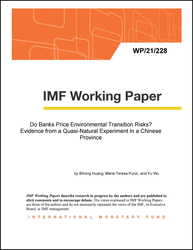
Do Banks Price Environmental Transition Risks? Evidence from a Quasi-Natural Experiment in a Chinese Province
Do Banks Price Environmental Transition Risks? Evidence from a Quasi-Natural Experiment in a Chinese Province
READ MORE...
Volume/Issue:
Volume 2021
Issue 228
Publication date: September 2021
ISBN: 9781513590219
$5.00
Add to Cart by clicking price of the language and format you'd like to purchase
Available Languages and Formats
| English |
Prices in red indicate formats that are not yet available but are forthcoming.
Topics covered in this book
This title contains information about the following subjects.
Click on a subject if you would like to see other titles with the same subjects.
Banks and Banking , Labor , Economics- Macroeconomics , Economics / General , Environmental Economics , Public Policy- Environmental Policy , E-DSGE Model , Financial stability , Clean Air Action Plan , transition risk , baseline analysis , default rate , data source , capital market department , Loans , Environmental policy , Commercial banks , Self-employment , Global
Summary
This paper assesses the financial risks arising from transition toward a low-emission economy. The environmental DSGE model shows tightening environmental regulation impairs firms’ balance sheets, and consequently threatens financial stability in the short term. The empirical analysis indicates that following the implmentation of Clean Air Action Plan, the default rates of high-polluting firms in a Chinese province rose by around 80 percent. Joint equity commercial banks with higher level of independence were able to appropriately price in their exposure to transition risks, while the Big Five commercial banks failed to factor in such risks.
Copyright © 2010 - 2025
Powered by:
AIDC



